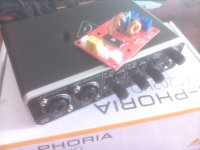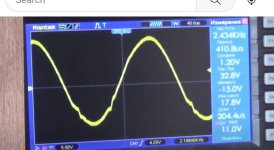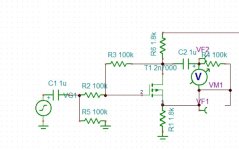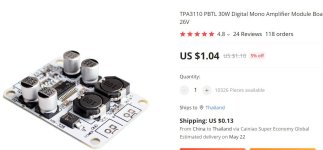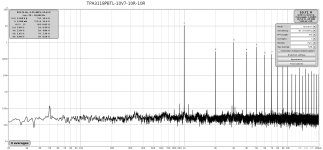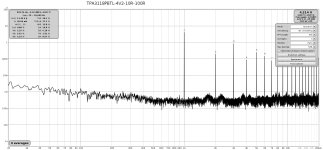H
HAYK
I do have a Behringer UM202 to measure in differential, unfortunately the keyboard of my MSI lap top is stuck. Most amplifiers I converted, have been measured by many, it can only be better specially at low power.
If I tell you that it has 2.5% 2nd harmonic, 0.5% 3rd and IMD of 3%, you might be disgusted. This what Audio magazine measured the professional Shure V MK3 pick up cartridge in 70's. For me the sound comes first, only if it is very good that I measure to see what makes it sound good.
Since I discovered the ABD mod, I decided to put an end to linear amplifiers that for half a century I was tormenting with, so I am designing since, my last linear amplifier trying to make it as much distortion as the Luxman MQ68C can, that is 0.5% of mainly 3rd harmonic but opposite phase, from 0 to max watts. I think I still need more than one year.
Once I get a great sounding amp, I will deal only with DSP programming to make the amplifier sound as SE triodes or dynamic comp./expansion and make it sound as any amp of choice by harmonic manipulation.
If I tell you that it has 2.5% 2nd harmonic, 0.5% 3rd and IMD of 3%, you might be disgusted. This what Audio magazine measured the professional Shure V MK3 pick up cartridge in 70's. For me the sound comes first, only if it is very good that I measure to see what makes it sound good.
Since I discovered the ABD mod, I decided to put an end to linear amplifiers that for half a century I was tormenting with, so I am designing since, my last linear amplifier trying to make it as much distortion as the Luxman MQ68C can, that is 0.5% of mainly 3rd harmonic but opposite phase, from 0 to max watts. I think I still need more than one year.
Once I get a great sounding amp, I will deal only with DSP programming to make the amplifier sound as SE triodes or dynamic comp./expansion and make it sound as any amp of choice by harmonic manipulation.
Attachments
Referring to your intro I understood you want to create low distiontion amps. Now you are designing ultra high distortion amps. I do not get it.
H
HAYK
Distortion numbers do not speak about sound quality. This what I show. What makes it sound bad is the data loss that the ear cannot correct. It happens with crossover, saturation and shown on the signal bellow, dead time when the signal is cut. With analog amplifiers is possible to inject harmonics but not the case with class D. For TPA3255, I prepared a phase splitter instead of opamps that inject 0.02% 2nd harmonics to the signal, in sort of adding sugar to a lemonade.
Retry adding resistor of 120 ohm on the board bellow and listen and measure again.
https://www.aliexpress.com/item/327...!sea!TH!4284450371&curPageLogUid=DHD0rAGeJGME
Retry adding resistor of 120 ohm on the board bellow and listen and measure again.
https://www.aliexpress.com/item/327...!sea!TH!4284450371&curPageLogUid=DHD0rAGeJGME
Attachments
If you want to build a true state of the art music reproduction system, you will find that distorsion is an obstacle for you goal. But its like sugar for a kid - wonderful but dangerous. As you grow up your taste matures and very sweet things taste sh*t. 😎 Thats how I see it.
//
//
What constitutes state-of-the-art depends on what is the endmost performance goal. Is it strictly the objective goal of reducing measurable signal path artifacts, such as distortion, to multiple orders of magnitude below human hearing detection thresholds, or maybe even to reduce them further than that, to below instrumentation detection thresholds? Or, rather, is the goal to obtain reproduction which subjectively sounds closest to the live sounding event? Presently, and for understandably practical reasons, we use a component's objective measurements as a proxy for determining which component provides the superior reproduction performance to the ear. Which comes back to the question of what is the endmost performance goal, and therefore, design goal?
State of the art means the most truthful reproduction. Adding distortion can not be a path towards that - any argument against this is non sensical.
Thesis: If one prefers added distortion in a system, there is an other error present that needs tp be fixed as the distortion is only "sugar" to the dish. Once that error is removed and you also remove the added distortion, glory will be before you.
I'ts just that you haven't heard any such system.... this is why many cling to the suger - but if suger is present in a system, further improvement will not be possible as any improvement made will most probably be refused - this is how one anchors the progress of a system - add distortion...
//
Thesis: If one prefers added distortion in a system, there is an other error present that needs tp be fixed as the distortion is only "sugar" to the dish. Once that error is removed and you also remove the added distortion, glory will be before you.
I'ts just that you haven't heard any such system.... this is why many cling to the suger - but if suger is present in a system, further improvement will not be possible as any improvement made will most probably be refused - this is how one anchors the progress of a system - add distortion...
//
H
HAYK
I am not designing any class D amp here, I am just converting for better. If you are so short for a dollar to try out the ABD mod, PM me any address and your birthday and I'll mail to you as present. It works at the voltage as your Infineon.
What concerns my last amp the, Ultima, is certainly not suitable to be posted on this website as it is elaborated on eevbolg.com
You are right about the sugar harmonics. This why using DSP to modify the sound, you will be able to choose the type you would like.
What concerns my last amp the, Ultima, is certainly not suitable to be posted on this website as it is elaborated on eevbolg.com
You are right about the sugar harmonics. This why using DSP to modify the sound, you will be able to choose the type you would like.
Here are THD-plots I took 2 days ago testing my TPA3118 PBTL module operating in BD-mode, powered with 18V= feeding 1kHz/10Vrms into 10R dummy load. With all settings untouched you find the result with 0R, 10R and 100R. This tells more about this promising mod than any comment.
Attachments
H
HAYK
27% distortion is visible on scope with sine wave, and I don't see my deformation on sine wave specially such high 2nd harmonic should make it vertically dissymmetric . Why perfectly symmetrical output would generate dissymmetric distortion? Something wrong in your differential measuring, probably you are using single ended input sound card.
I'll try to fix my laptop and measure it.
I'll try to fix my laptop and measure it.
H
HAYK
My scope's FFT shows 0.5% at 5W which is nearly the distortion of my generator. I am testing the TPA3110
H
HAYK
Take off the grounding resistor, let the capacitors float, then you are running in BD mod and you should see only odd harmonics.
H
HAYK
Your circuit is corrupt. This is standard BD mod for which the TPA31xx are conceived to function and produce minimum EMI and very low dissipation. See the output snubbers if both are cut.
Certainly my fault, how could that be otherwise. You may find somebody else to confirm your mod, I am out here.
Truthful to which, the sound of the original performance, or to the signal transfer path? They are not inherently one the same.State of the art means the most truthful reproduction. Adding distortion can not be a path towards that - any argument against this is non sensical.
Last edited:
- Home
- Amplifiers
- Class D
- Convert your class D into ABD modulation
